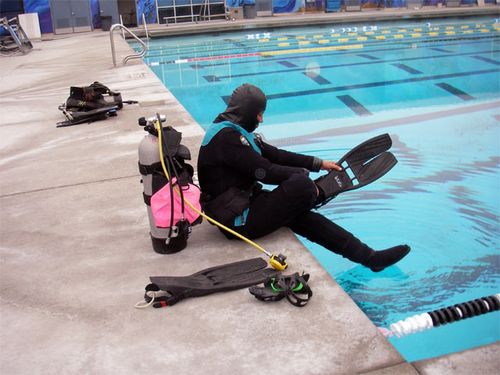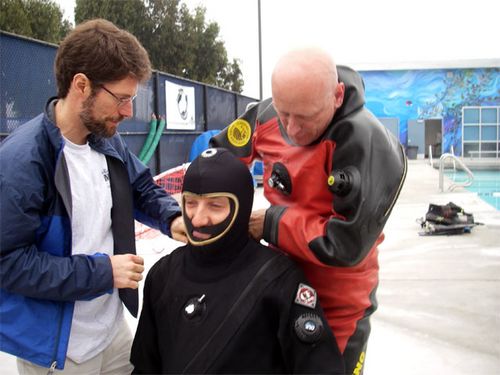This is my first visit to California and I am very excited. I am going to attend an orientation meeting where I will meet the other members of the research team. I am a little nervous because I don't know what the others will be like. After all, I'll be living with them for over six weeks and I really hope they're nice. The meeting is being held in Moss Landing, California. This is a quaint city located on the coast near Monterey, California. ARCUS, which stands for Arctic Research Consortium of the United States, is the organization that administers PolarTREC and they have graciously agreed to fund this trip. They have arranged for me to stay in a lovely bed and breakfast that is located right next to Moss Landing Marine Laboratories.
 The Captain's Inn in Moss Landing, California is situated on the water and is home to a large variety of wildlife.
The Captain's Inn in Moss Landing, California is situated on the water and is home to a large variety of wildlife.
Stacy Kim (the lead researcher) and her husband Bob Zook (the chief gizmologist) picked me up at 7:00am this morning to go to a local swimming pool. The plan was for the four divers to practice various maneuvers underwater and the other members of the research team would practice being dive tenders. In case you were wondering, a dive tender is someone who helps a diver get ready to dive and then helps them out of the water. The four divers are Stacy, Bob, Marco, and Francois. The dive tenders include me, Jeff, Jim, DJ, and Scott. All of the members of the research team, with the exception of Scott, are experienced wet suit divers and this definitely helps. However, wet suit diving is not the same as diving with a dry suit.
Diving in Antarctica involves using a dry suit to help deal with the extremely cold water. Dry suit diving also involves using a lot more equipment. Here is a picture of some of the items you will need.
 Scuba gear for a dry suit dive includes a dry suit, gloves, a face mask, weights, various dive instruments, and a tank of oxygen.
Scuba gear for a dry suit dive includes a dry suit, gloves, a face mask, weights, various dive instruments, and a tank of oxygen.
However, to properly conduct a dry suit dive you will need quite a bit more. The first step is to put on a base layer. This is a picture of Stacy in her base layer. However, she is wearing cotton which is a no-no for diving in Antarctica (I will tell you more about the proper type of clothing you should wear in a later journal entry).
 Stacy is wearing a top and pants as the first layer and the second layer is on the ground at her feet.
Stacy is wearing a top and pants as the first layer and the second layer is on the ground at her feet.
The next step is to put on a warm layer of clothing. This layer looks very similar to a suit you might wear if you were on the ski slopes. The third layer of clothing is the dry suit which is made of neoprene.
 Marco is wearing his dry suit and Jeff is helping him with the zipper.
Marco is wearing his dry suit and Jeff is helping him with the zipper.
The next step is to put on a dive hood or should I say hoodss. A diver may wear two or even three hoods when doing a dry suit dive.
 A diver will wear two or three dive hoods when doing a dry suit dive.
A diver will wear two or three dive hoods when doing a dry suit dive.
You next want to put on your flippers. These will help you move smoothly through the water. The diver will usually put on a mask at this time because they still have full use of their hands. They use spit (yes, I said spit) to clean the mask.
 Flippers help you move smoothly and swiftly through the water.
Flippers help you move smoothly and swiftly through the water.
The next step is to put on your gloves. This sounds like an easy process but things are not always as they seem. You first put on a layer of gloves that are made of a thick cotton material. Then the dive tender helps you put on a pair of outer gloves that need to fit over the first pair of gloves and also need to cover the wrists. There is a set of dry suit seals in each wrist that help keep the suit free of water. The gloves need to cover the rim of the dry suit seal.
 It takes at least two people to properly apply the two layers of gloves. You need to make sure that the outer layer covers the rim of the dry suit seal.
It takes at least two people to properly apply the two layers of gloves. You need to make sure that the outer layer covers the rim of the dry suit seal.
The dive tenders then check the edges of all of the seams for the diver. This includes around the face, neck, and wrists. If the seals are not correct, then water will get into the dry suit and the diver will get very cold.
 Bob (in the red dry suit) and Scott are checking the seals on Francois's dry suit.
Bob (in the red dry suit) and Scott are checking the seals on Francois's dry suit.
The diver will also wear weights, often on a belt, to help prevent them from floating to the surface. They usually use a tank of compressed air to breathe when they are diving. You may also notice various instruments hanging from the diving suit. These will include a dive computer, a compass, and a depth gauge.
 Jim is helping Bob put on his tank of compressed air. Notice the blue weight belt around Bob's waist that will help him counteract his buoyancy.
Jim is helping Bob put on his tank of compressed air. Notice the blue weight belt around Bob's waist that will help him counteract his buoyancy.
The divers went underwater and performed several tests to prepare for Antarctica. It sure looks like they were having fun!
 Bob used my camera to take a picture of Francois, Stacy, and Marco practicing with the underwater cameras we will use in Antarctica.
Bob used my camera to take a picture of Francois, Stacy, and Marco practicing with the underwater cameras we will use in Antarctica.
After the practice at the swimming pool, we all went to the Moss Landing Marine Laboratories and participated in several orientation activities. I was pleased to see that all of the members of the team were definitely nice and just as excited about going to Antarctica as I am. Tomorrow we are going out on a boat. I can't wait!

